AUDI S8 2014 Owners Manual
Manufacturer: AUDI, Model Year: 2014, Model line: S8, Model: AUDI S8 2014Pages: 314, PDF Size: 78.47 MB
Page 251 of 314
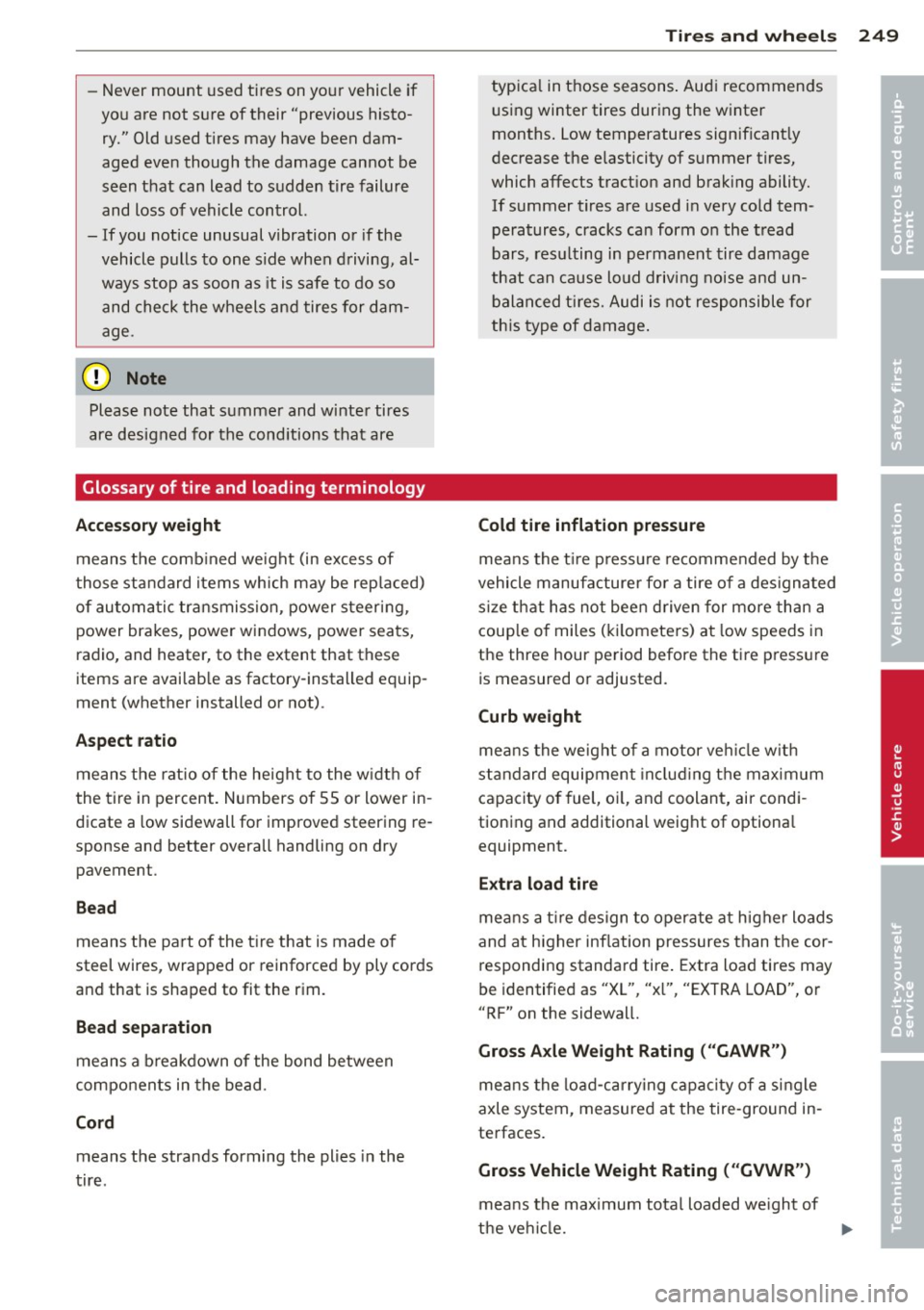
-Never mount used tires on yo ur vehicle if
yo u are not sure of their "previous histo
ry." Old used tires may have been dam
aged even though the damage cannot be
seen that can lead to sudden tire failure
and loss of vehicle control.
- If you notice unusual vibration or if the
vehicle pulls to one side when d riving, al
ways stop as soon as it is safe to do so
and check the wheels and tires for dam
age .
(D Note
Please note that summe r and wi nte r tires
are designed for the cond itions that are
Glossary of tire and loading terminology
Accessory weight means the comb ined weight (in excess of
those sta ndard items which may be rep laced)
of au toma tic transmission, power steer ing ,
power brakes, power windows, power seats,
radio, and heater, to the extent that these
items are availab le as factory-installed equip
ment (whether installed or not) .
Aspect ratio
means the rat io o f the height to the w idth of
the tire in percent . Numbers of 55 or lower in
dicate a low sidewall for improved steering re
sponse and better overa ll handling on dry
pavement .
Bead
means the part of the t ire t hat is made o f
steel wires, wrapped or reinforced by ply cords
and that is shaped to fit the r im.
Bead separation
means a b reakdown of the bond between
components in the bead .
Cord means the strands forming the plies in the
tire.
Tire s an d wheel s 249
typica l in those seasons . Aud i recommends
using winter tires during the winter
months . Low temperatures signif icant ly
dec rease the e lasticity of summer t ires,
which affects tract ion and brak ing ability.
If summer t ires are used i n very co ld tem
peratures, cracks ca n form o n the tread
bars , res ulting in perma nen t tire damage
that can cause loud driving noise and un
bala nced ti re s. Audi i s not respon sible for
th is type of damage .
Cold tire inflation pressure
means the t ire p ress ure recommended by t he
vehicle manufacture r fo r a tire o f a des ignated
s ize t hat has not bee n driven for more than a
coup le o f miles (k ilometers) at low speeds in
the three hour period before the tire press ure
is m easured or adjusted.
Curb weight
me ans the we ight of a motor ve hicle with
st andard equipmen t incl ud ing the max imum
capacity of fuel, oi l, and coolant, air condi
tioning and additional weig ht of optiona l
equipment.
Extra load tire
means a t ire design to oper ate a t higher load s
and at higher inflation pressures than the cor
responding standa rd tire . Extra load tires may
be identified as "XL", "x l", "EXTRA LOAD", o r
"RF" on the sidewal l.
Gross Axle Weight Rating ("GAWR")
me ans the load-ca rry ing capac ity of a single
axle system , measured at the tire -ground in
te rfaces.
Gross Vehicle Weight Rating ( "GVWR ")
mea ns the maximum total loaded we ight of
the ve hicl e. .,..
•
•
Page 252 of 314
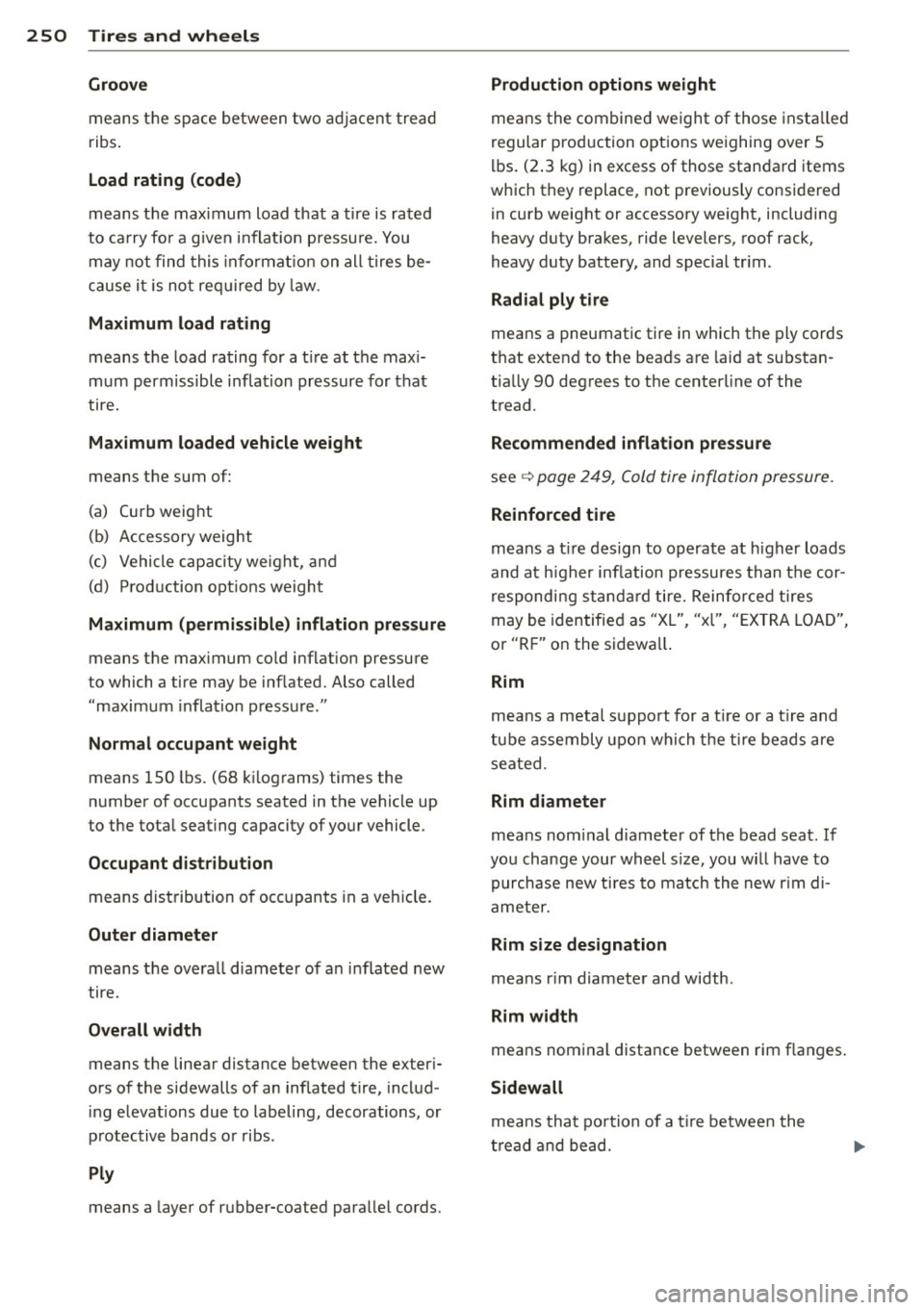
250 Tires and wheels
Groove
means the space between two adjacent tread
ribs .
Load rating (code)
means the maximum load that a tire is rated
to carry for a given inflation pressure. You
may not find this informat ion on all tires be
cause it is not req uired by law.
Maximum load rating
means the load rating for a t ire at the max i
mum permissible inflation pressure for that
tire.
Maximum loaded vehicle weight
means the sum of:
(a) Curb weight
(b) Accessory weight
(c) Vehicle capacity we ight, and
(d) Production options weight
Maximum (permissible) inflation pressure
means the maximum cold inflation pressure
to which a tire may be inflated. Also called
"maximum inflation pressure ."
Normal occupant weight
means 150 lbs. (68 kilograms) times the
number of occupants seated in the vehicle up
to the total seating capacity of your vehicle .
Occupant distribution
means distribution of occupants in a vehicle.
Outer diameter
means the overa ll diameter of an inflated new
tire.
Overall width
means the linear distance between the exteri
ors of the sidewalls of an inflated tire, includ
ing elevations due to labeling, decorations, or
protective bands o r ribs .
Ply
means a layer of rubber-coated parallel cords.
Production options weight
means the combined weight of those insta lled
regular production options weighing over 5
lbs. (2.3 kg) in excess of those standard items
which they replace, not previously considered
in curb weight or accessory we ight, including
heavy duty brakes, ride levelers, roof rack,
heavy duty battery, and special tr im .
Radial ply tire
means a pneumat ic tire in which the ply cords
that extend to the beads are laid at substan
t ia lly 90 degrees to the center line of the
tread .
Recommended inflation pressure
see<=> page 249, Cold tire inflation pressure.
Reinforced tire
means a t ire design to operate at higher loads
and at h igher inflation pressures than the cor
responding standa rd tire. Reinforced tires
may be identified as "XL" "xl" "EXTRA LOAD"
' ' '
or "RF" on the sidewa ll.
Rim
means a metal support for a tire or a tire and
tube assembly upon which the tire beads are
seated.
Rim diameter
means nom inal diameter of the bead seat. If
you change your wheel s ize, you will have to
purchase new tires to match the new rim di
ameter.
Rim size designation
means r im diameter and width .
Rim width
means nominal distance between rim flanges.
Sidewall
means that portion of a tire between the
t read and bead.
Page 253 of 314
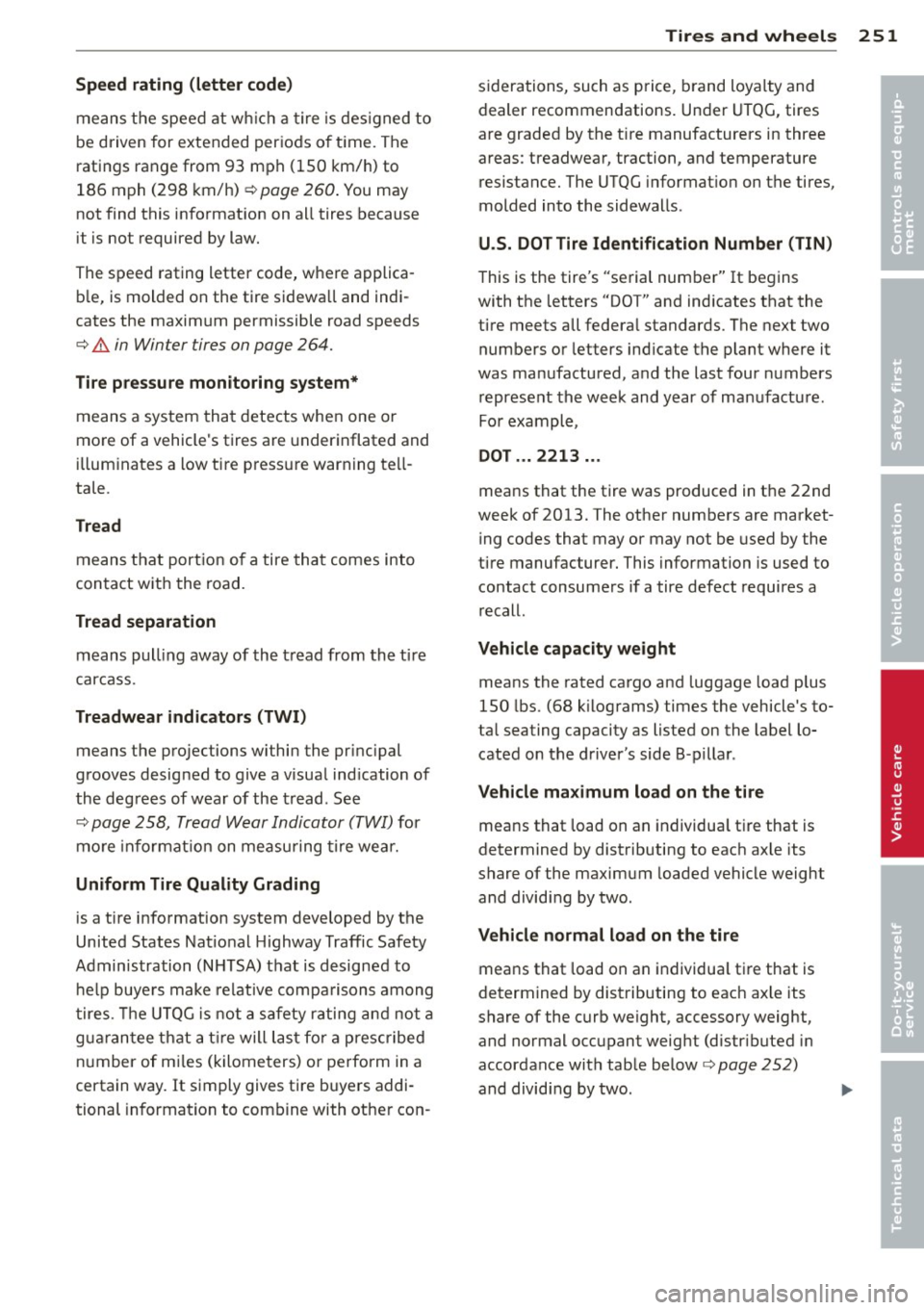
Speed rating (letter code)
means the speed at wh ich a tire is des igned to
be driven for extended periods of t ime . The
ratings range from 93 mph (150 km/h) to
186 mph (298 km/h) ¢
page 260 . You may
not find this information on all tires because
it is not required by law.
The speed rating letter code, where applica ble, is molded on the tire sidewall and indi
cates the maximum permissible road speeds
¢ &. in Winter tires on page 264.
Tire pressure monitoring system*
means a system that detects when one or
more of a vehicle's tires are underinflated and
illuminates a low tire pressure warn ing te ll
tale .
Tread
means that port ion of a tire that comes into
contact with the road.
Tread separation
means pulling away of the tread from the tire
carcass .
Treadwear indicators (TWI)
means the projections within the pr incipal
grooves designed to give a visual ind ication of
the degrees of wear of the tread. See
¢
page 258, Tread Wear Indicator (TWI) for
mo re inf ormat ion on measuring tire wear.
Uniform Tire Quality Grading
is a tire information system developed by the
United States National Highway Traffic Safety
Admin istration (N HTSA) that is designed to
help buyers make relative comparisons among
tires . Th e U TQG is not a safety rating and not a
g ua ran tee that a tir e will last for a prescribed
number of mi les (kilometers) or perform in a
certain way.
It simply gives tire buyers addi
tional information to combine with other con-
Tires and wheels 251
siderations, such as price, brand loyalty and
dealer recommendations. Under UTQG, tires
are graded by the t ire manufacturers in three
areas : treadwear, traction, and temperature
resistance. The UTQG informat ion on the tires,
molded into the sidewalls .
U.S. DOT Tire Identification Number (TIN)
This is the tire's "serial number" It begins
with the letters "DOT" and indicates that the
tire meets all federa l standards. The next two
numbers or letters indicate the plant where it
was manufactured, and the last four numbers
represent the week and year of manufacture.
For example,
DOT ... 2213 ...
means that the tire was produced in the 22nd
week of 2013. The other numbers are market
ing codes that may or may not be used by the
tire manufacturer. This information is used to
contact consumers if a tire defect requires a
recall.
Vehicle capacity weight
means the rated cargo and luggage load plus
150 lbs. (68 k ilograms) times the vehicle's to
tal seating capacity as listed on the label lo
cated on the driver's side B -pillar .
Vehicle maximum load on the tire
means that load on an individual tire that is
determined by distributing to each axle its
share of the maximum loaded vehicle weight
and dividing by two.
Vehicle normal load on the tire
means that load on an individual tire that is
determined by distributing to each ax le its
share of the curb weight, accessory weight,
and normal occupant weight (distr ibuted in
accordance with table below¢
page 252)
and dividing by two.
•
•
Page 254 of 314
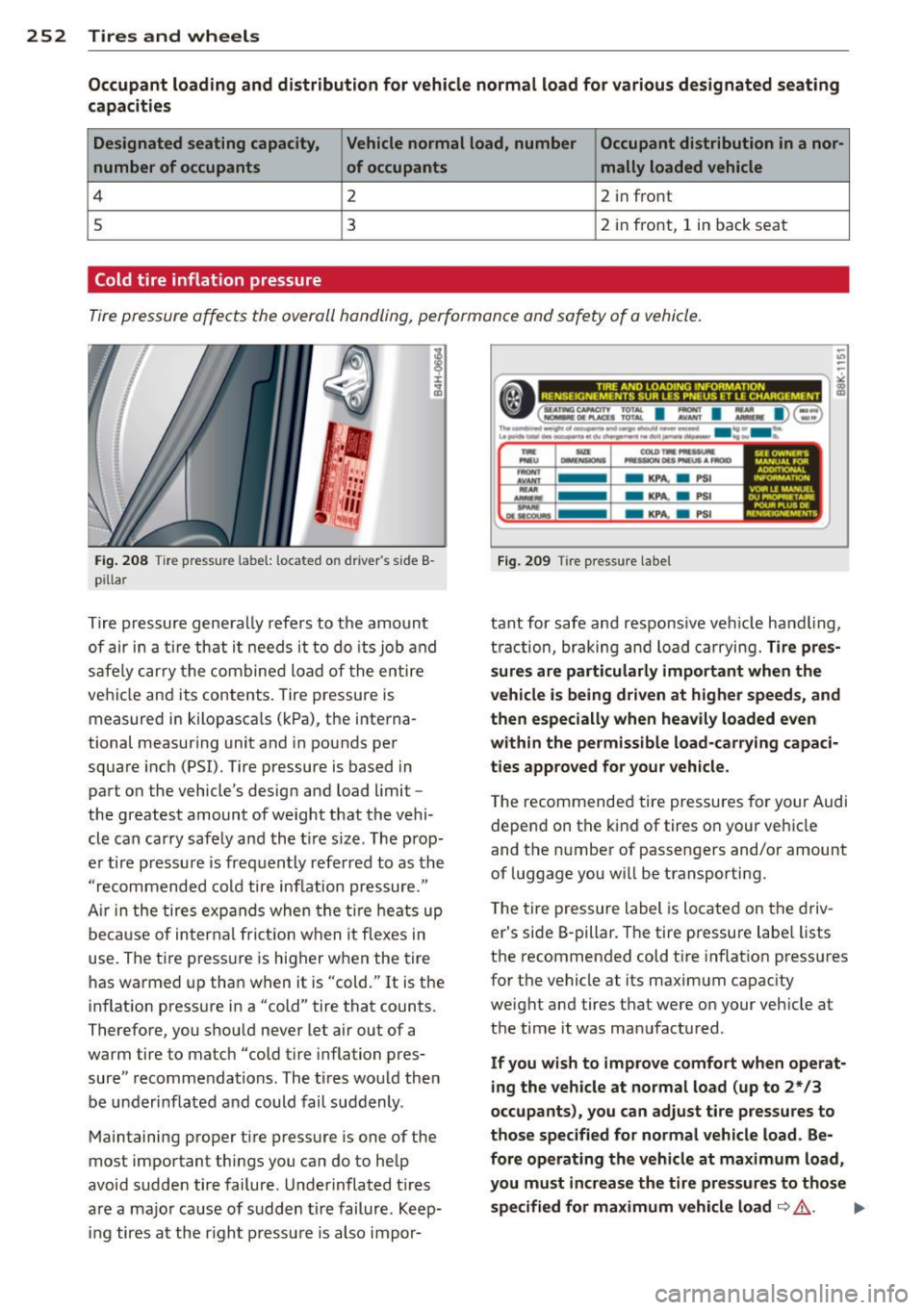
252 Tires and wheels
Occupant loading and distribution for vehicle normal load for various designated seating
capacities
Designated seating capacity, Vehicle normal load , number Occupant distribution in a nor -
number of occupants of occupants mally loaded vehicle
4 2 2 i
n front
5 3 2 i n fro nt, 1 in back seat
Cold tire inflat ion pressure
Tire pressure affects the overall handling, performance and safety of a vehicle.
Fi g. 20 8 Tire p ressu re label: located on drive r's si de 8 -
p ill ar
T ire pressure gene ra lly refers to the amo unt
of air i n a tir e th at i t needs it to do its job and
s a fe ly c arry the combined load of the entire
ve hicl e and its contents . Tire pressure is
measured in kilopasca ls (kPa), the i nterna
tional measuring unit and in pounds per
squa re inc h (PSI). Tire pressure is based in
part o n the vehicle's design and load limit -
the greatest amount of we ight that the vehi
cle can car ry safely an d the t ire s ize . The prop
e r tire p ressu re is freq uen tly referred to as the
"recommende d cold tire inf lation pressure."
A ir in the tires exp ands when the ti re heats up
beca use of in ter nal fri ct ion when i t flexes in
use. The tire p ress ure is higher when the tire
has warmed up tha n when it is "cold." It is the
inflat ion pressure in a "cold" tire that counts.
Therefore, you sho uld never let air out of a
warm tire to match "cold ti re inflation pres
sure" recommendations. The t ires wo uld the n
be underinflated a nd could fail suddenly .
Maintaining proper t ire p ress ure is one of the
most important things you can do to he lp
avoid sudden tire failure . Underinflated t ires
a re a majo r ca use of s udden tire failure. Keep
ing tires a t the r ight pressu re is also impor-
-~
-
( • (==. ~r: I := I :... 1)-~- -:-i
n. ........... ....,. .................... ,...,,.. ...... ...... .. '--............................................... ·-..
TN IIZE CO.O TN.,,.... ,.,._u OWlHSIONt ......,., DU ,.,._ua .-,--
-.....
--...........
- KP aPSI
- ICPA. a PSI
- ICPA. a PSI
Fig. 209 Tire p ressu re labe l
SEEOWHf:ft"S MA. NUAl FOR
IHFOll:MA TION Va.t Lf M>.MJ!:L
OU PltOPfllE f A.IN: ,ol.M "-.UtDf NNSCIOM.:MErtf5
tant for safe an d respo ns ive ve hicle ha ndling,
t raction, br aking and load ca rrying .
Tire pres
sures are particularly important when the
vehicle i s being dr iven at higher speeds, and
then especially when heavily loaded even
within the permissible load-carrying capaci
ties approved for your vehicle .
The recommende d tire pressures for your Audi
depen d on t he kind of tires o n your vehicle
and the number of passengers and/or amount
of luggage you w ill be transporti ng.
T he tire pressure label is located on the d riv
er's side B -pillar . The tire pressure labe l lists
the recommended cold t ire inflat ion pressures
fo r the vehicle at its maxim um capac ity
weight and tires t hat were on your veh icle at
t h e time it was ma nufactured.
If you wish to improve comfort when operat
ing the vehicle at normal load (up to 2* /3
occupants ), you can adjust t ire pressures to
those specified for normal vehicle load. Be·
fore operating the vehicle at maximum load,
you mu st increase the tire pres sures to those
specified for maximum vehicle load
i:::> .&, . II>-
Page 255 of 314
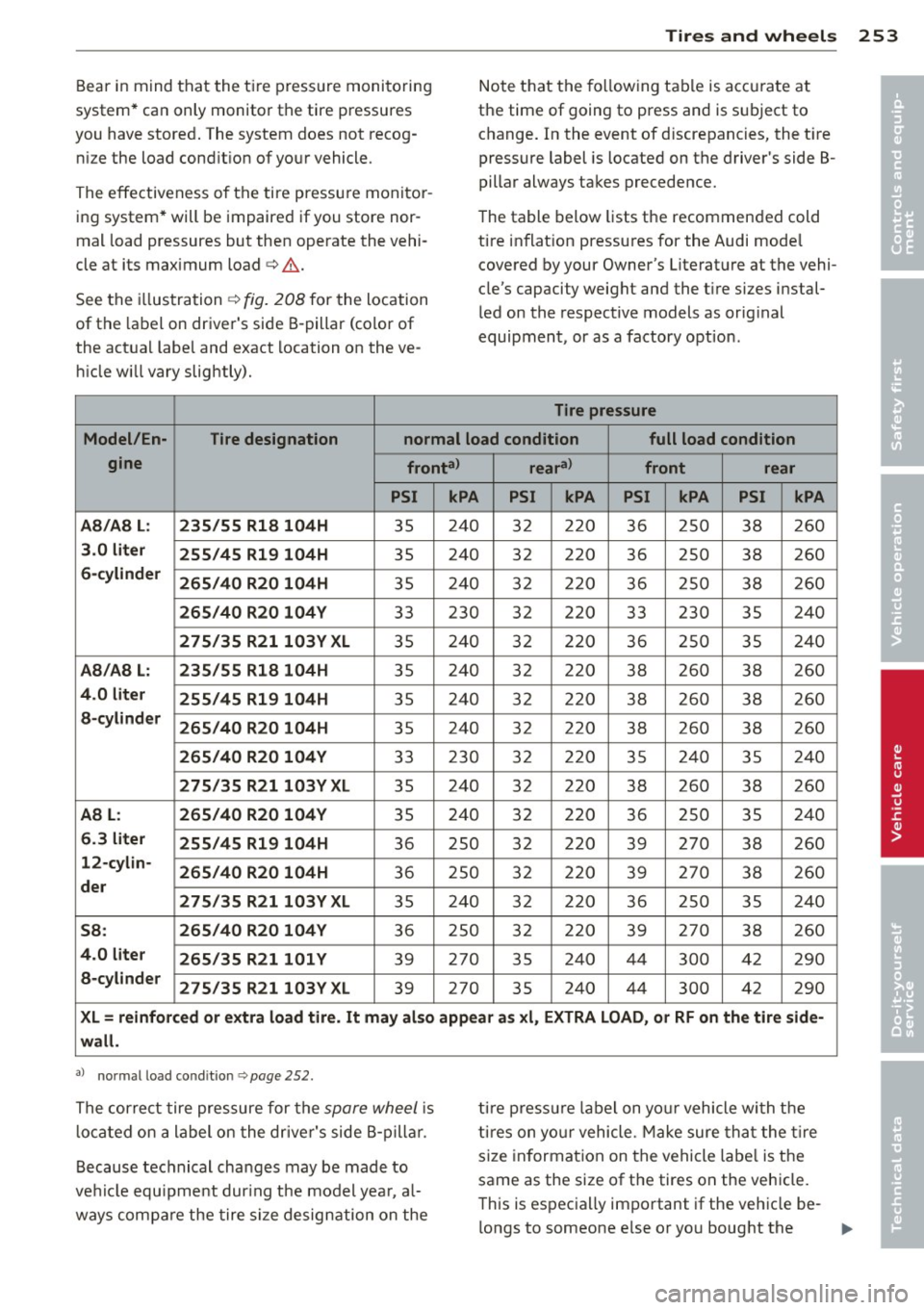
Tires an d wheel s 253
Bear in mind that the ti re press ure monitoring
system* can only monitor the tire pressures
you have stored. The system does not recog
n ize the load condit ion of your vehicle.
The effectiveness of the tire pressure monitor
ing system* will be impaired if you store nor
mal load pressures but then operate the vehi
cle at its maximum load
c;, &.
See the i llustration c;, fig. 208 for the location
of the label on driver's side B-pillar (co lor of
the actua l labe l and exact location on the ve
h icle wi ll vary slightly). Note that the
following table is accurate at
the time of going to press and is subject to
change. In the event of d iscrepancies, the tire
pressure label is located on the driver's side B
pillar always takes precedence.
The table below lists the recommended cold
tire inflat ion pressures for the Audi mode l
covered by your Owner's Literature at the vehi
cle's capacity weight and the t ire sizes instal
led on the respective models as orig inal
equipment, or as a factory option.
Tire pressure
Model /En-
Tire design ation normal load condition
full load condition
gine fronta> reara>
front rear
PSI kPA PSI kPA PSI kPA PSI kPA
AB /AB L: 235/55 R18 104H
35 240 32 220 36 250 38 260
3 .0 lit er
255/45 R1 9 104H 35 240
32 220 36 250 38 260
6-cy lind er
26 5/40 R2 0 104H 35 240 32 220 36 250 38 260
265 /40 R20 104 V 33 230 32 220 33 230 35 240
275
/35 R 2110 3Y XL 35 240 32 220 36 250 35 240
A8/A8 L: 235 /55 R1 8 104H 35 240
32 220 38 260 38 260
4.0 l it e r
255/4 5 R19 104H 35 240 32 220 38 260 38 260
a-cy lind er
26 5/ 40 R 20 104H 35 240
32 220
38 260
38 260
2
6 5/40 R 20 104V 33 230 32 220 35 240 35 240
27
5/35 R2 110 3Y XL 35 240 32
220
38 260
38 260
AB L
: 265/40 R20 104 V 35 240 32 220 36 250 35 240
6.3 liter
255 /45 R1 9 104H 36 250 32 220
39 270
38 260
12
-cy lin-
26 5/40 R 20 104H 36 250 32 220 39 270 38 260
der
275/35 R 21 103 YXL
35 240 32 220 36 250
35 240
58
: 2 65/40 R 20 10 4V 36 250 32 220 39 270 38 260
4.0 liter
265 /35 R21101 Y 39 270 35 240 44 300 42 290
a-cy lind er
275/35 R 2110 3Y XL 39 270 35 240
44
300 42
290
XL= reinf orce d or extra lo ad tir e. It ma y als o appe ar a s x l, E XTRA LOAD, or RF on th e tire s ide-
w all .
al no rmal load co ndit ion c:> page 252.
The correct tire pressure for the spare wheel is
l ocated on a label on the dr iver's side B-pilla r.
Because technical changes may be made to
ve hicle equ ipment dur ing the model yea r, a l
ways compa re the tire size designation on the tire pressu
re label on you r vehicle with the
t ires on you r vehicle. Make sure that the t ire
size in formation on the vehicle labe l is the
same as the size of the tires on the vehicle.
This is especially important if the vehicle be-
l ongs to someone else or yo u bought the ...,
•
•
Page 256 of 314
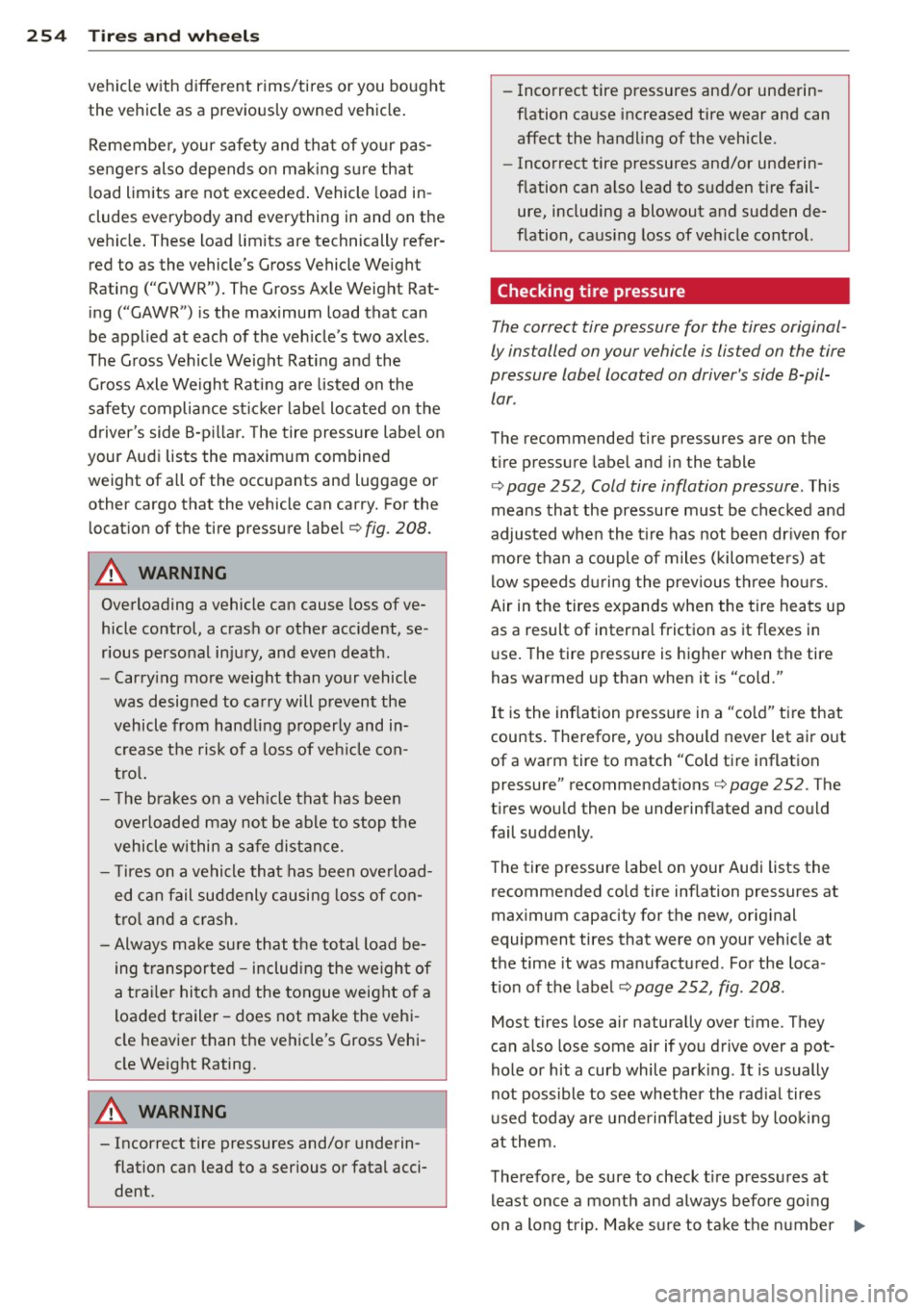
254 Tire s and wheel s
vehicle with diffe rent rims/ti res or you bought
the vehicle as a previously owned vehicle.
Remembe r, your safety and that of your pas
sengers also depends on mak ing sure that
l oad limits are not exceeded . Vehicle load in
cludes everybody and everything in and on the
ve hicle . These load limits are technically refer
red to as the vehicle's Gross Vehicle We ight
Rating ("GVWR"). The Gross Axle Weight Rat
ing ("GAWR") is the maximum load that can
be applied at each of the veh icle 's two axles.
The Gross Vehicle Weight Rating and the
Gross Axle Weight Rat ing a re listed on the
safety compliance st ic k er labe l located on the
d river's side B-p illar. T he tire pressure label on
your Audi lists the maximum combined
weight of a ll of the occupants and luggage or
othe r cargo that the vehicle can carry. For the
locat ion of the tire pressure label¢
fig. 208.
A WARNING
Overloading a vehicle can cause loss of ve
hicle control, a cras h or other acc ident, se
r ious personal in ju ry, and even death.
- Carry ing more weight than your vehicle
was designed to carry will prevent the
vehicle from handling p roperly and in
cr ease the risk of a loss of veh icle con
tro l.
- T he brakes on a veh icle that has been
overloaded may not be ab le to stop the
vehicle within a sa fe distance.
- Ti res on a vehicle that has been ove rload
ed can fail suddenly causing loss of con
tro l and a crash .
- Always make su re that the tota l load be
ing t ransported -including the we igh t of
a tra ile r hi tc h and the tongue weight of a
loaded t ra iler -does not make the veh i
cle heavier than the ve hicle's Gross Vehi
cle Weight Rating.
A WARNING
- Incorrect tire pressures and/or underin
flation can lead to a serious or fatal accident .
-
'
-Incorrect tire pressures and/or underin
f lation ca use increased tire wear and can
affect the handling of the vehicle .
- Incorrect tire pressures and/or underin
flation can a lso lead to sudden t ire fail
ure, including a blowout and sudden de
flation, caus ing loss of veh icle control.
Checking tire pressure
The correct tire pressure for the tires original
ly ins talled on your vehicle is lis ted on the tire
pressure label located on driver's side 8-pil
lar .
The recommended tire pressures are on the
tire pressure label and in the table
¢
page 252, Cold tire inflation pressure. This
means that the pressure m ust be checked and
adjusted when the t ire has not been dr iven fo r
more than a couple of miles (kilomete rs) a t
low speeds d uring the prev ious t hree ho urs.
Air in the tires expands when the tire heats up
as a result of interna l friction as it flexes in
u se . T he tire pressure is higher when the tire
has warmed up than when it is "cold."
It is the inflation pressure in a "co ld" t ire that
counts . Therefore, you should never let air out
of a warm tire to match "Cold tire inflation
pressure" recommendat ions ¢
page 252 . The
t ires wou ld then be underinflated and could
fail suddenly .
The tire pressure label on your Audi lists the recommended co ld tire inflation pressures at
maximum capacity for the new, orig inal
equipment tires that were on your vehicle at
the time it was ma nufactu red . Fo r the loca
t ion of the label¢
page 252, fig . 208 .
Most tires lose air naturally over t ime . They
can a lso lose some air if you drive over a pot
hole or hit a curb while park ing . It is usually
not possible to see whether the rad ial tires
u sed today are unde rinflated just by loo kin g
at them.
T herefo re, be sure to check t ire p ressures at
least once a month and always befo re going
o n a long trip. Ma ke su re to ta ke the numbe r
II>-
Page 257 of 314

of people and the amount of luggage into ac
count when adjusting tire pressure for a trip -
even one that you would not consider to be
"long." See
c> page 256 , Tires and vehicle
load limits
for more important information.
Always use an accurate tire pressure gauge
when checking and adjusting inflation pres
sures . Check all of the tires and be sure not to
forget the spare tire. If the pressure in any tire
is too high when the tire is "cold," let air out
of the tire slowly with the edge of the tire
gauge and keep checking the pressure until
you reach the pressure that is correct for the
load (passengers and luggage) and kind of
driving you plan to do.
If the pressure in any tire is too low, note the
difference between the pressure in the cold
tire and the pressure you need and add the air
that you need to reach the correct pressure for
the vehicle load (passengers and luggage) for
the tires on your vehicle as listed on the on
your vehicle and in this manual and the kind
of driving you plan to do.
Never exceed the maximum inflation pres
sure listed on the tire sidewall for any rea
son.
Remember that the vehicle manufacturer, not
the tire manufacturer, determines the correct
tire pressure for the tires on your vehicle.
It is important to check the tire pressure when
the tires are cold.
- Read the required tire pressure from the tire
pressure label. The tire pressure label is lo
cated on the driver's side 8-pillar.
- Turn the valve stem cap counter-clockwise
to remove it from the tire valve.
- Place the air pressure gauge on the valve .
- The tire pressures should only be checked
and adjusted when the tires are cold . The
slightly raised pressures of warm tires must
not be reduced.
- Adjust the tire pressure to the load you are
carrying.
- Reinstall the valve stem cap on the valve .
Tires and wheels 255
When should I check the tire pressure?
The correct tire pressure is especially impor
tant at high speeds. The pressure should
therefore be checked at least once a month
and always before starting a journey. Do not
forget to check the tire pressure for the spare
wheel
c::;,page 271.
When should I adjust the tire pressures?
Adjust the tire pressure to the load you are
carrying. After changing a wheel
or replacing
wheels you have to adjust the tire pressures on all wheels. In addition, you must then
store the new tire pressures in the tire pres
sure monitoring system*
c::;, page 266 .
A WARNING
Incorrect tire pressures and/or underinfla
tion can lead sudden tire failure, loss of
control, collision, serious personal injury
or even death.
- When the warning symbol
[I] appears in
the instrument cluster, stop and inspect
the tires.
- Incorrect tire pressure and/or underinfla
tion can cause increased tire wear and
can affect the handling of the vehicle and
stopping ability.
- Incorrect tire pressures and/or underin
flation can also lead to sudden tire fail
ure, including a blowout and sudden de
flation, causing loss of vehicle control.
- The driver is responsible for the correct
tire pressures for all tires on the vehicle.
The applicable pressure values are locat
ed on a sticker on the driver's side B-pil
lar.
- Only when all tires on the vehicle are fil led to the correct pressure, the tire pres
sure monitoring* system can work cor rectly .
- The use of incorrect tire pressure values
can lead to accidents or other damage .
Therefore it is essential that the driver
observe the specified tire pressure values
for the tires and the correct pressures for
IIJ,
•
•
Page 258 of 314
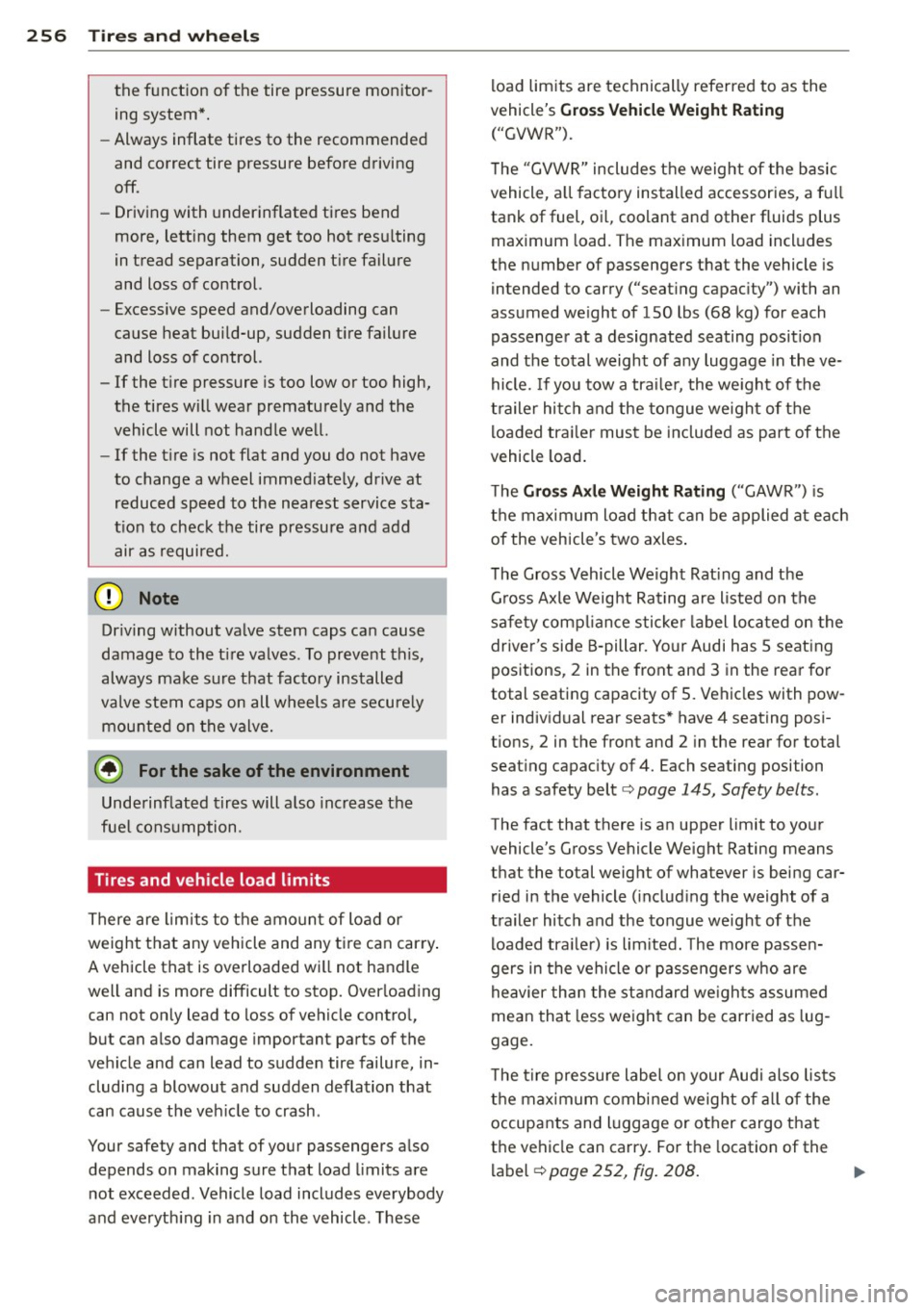
256 Tire s and wheel s
the function of the tire pressure monitor
ing system*.
- Always inflate tires to the recommended
and correct tire pressure before driving
off.
- Driv ing with under inflated tires bend
more, letting them get too hot resu lting
in tread separation, sudden t ire fail ure
and loss of control.
- Excess ive speed and/overloading can
cause heat bui ld-up, sudden t ire failure
and loss of control.
- If the t ire pressure is too low or too high,
the tires w ill wear prematurely and the
vehicle will not hand le we ll.
- If the t i re is not flat and you do not have
to change a wheel immed iate ly, dr ive at
reduced speed to the nearest service sta
t ion to check the tire pressure a nd add
air as required.
0 Note
Dr iving without va lve stem caps can cause
damage to the t ire va lves . To prevent this,
always ma ke sure that facto ry installed
valve stem caps on all wheels a re secu re ly
mou nte d on the valve.
@) For the sake of the environment
Unde rinflated tires will a lso inc reas e the
fue l cons umption .
Tires and vehicle load limits
There are limits to the amo unt of load or
weight that any vehicle and any t ire can carry .
A vehicle that is overloaded w ill not handle
well and is more difficult to stop. Overloading
can not only lead to loss of vehicle contro l,
but can also damage import ant parts of the
ve hicle and can lead to sudde n tire failure, in
cluding a blowout and sudden deflation that
can cause t he veh icle to crash .
Your safety and that of your passengers a lso
depends on making sure that load limits are
not exceeded . Vehicle load includes everybody
and everyth ing in and on the vehicle. These load lim
its are technically referred to as the
vehicle's
Gro ss Vehicle Weight R ating
("GVWR").
T he "GVWR" includes t he weight of the basic
vehicle , a ll f actory installed accessories, a f ull
tank of fuel, oi l, coo lant and other f luids plus
maximum load. The max imum load incl udes
the number of passengers that the vehicle is
intended to carry ("seat ing capac ity ") with an
assumed we ight of 150 lbs (68 kg) for each
passenger at a designated seating posit ion
and the total weight of a ny luggage in the ve
hicle. If you tow a trai le r, the we ight of the
t ra ile r hi tc h and the tongue we ight of the
l oaded tra iler mus t be include d as part of the
vehicle load .
T he
Gro ss Ax le Weight Rating ("GAWR ") is
the max imum load that can be applied a t each
of the veh icle's two axles .
T he Gross Vehicle Weight Rat ing and the
G ross Ax le Weig ht Ra ting are listed on the
sa fety comp lian ce s ticke r label located on the
driver's side B-pillar. Yo ur Audi has 5 seat ing
pos itions , 2 in the front and 3 in the rea r fo r
total seati ng capacity of 5. Vehicles with pow
er indiv idual rear seats * have 4 seating posi
tions, 2 in the front and 2 in the rear for total
seat ing capac ity of 4. Each seating position
has a safety belt¢
page 145, Safety belts.
The fact that there is an upper limit to yo ur
vehicle's Gross Vehicle Weight Rating means
that the to tal weight of wha tever is being car
ried in the vehicle ( includ ing t he weight of a
t ra ile r hitch and the tongue weight of the
loaded tra ile r) is lim ited. The more passe n
gers in the vehicle or passengers w ho are
he avier th an t he st andard we igh ts assumed
mean that less we igh t can be carried as lug
gage.
T he tire pre ssure label o n your Audi also lis ts
t h e max imum combine d weig ht of all of the
occupants and luggage or o ther cargo that
the vehi cle can carry . For the location of the
l abel ¢
page 252, fig . 208. liJJ>
Page 259 of 314
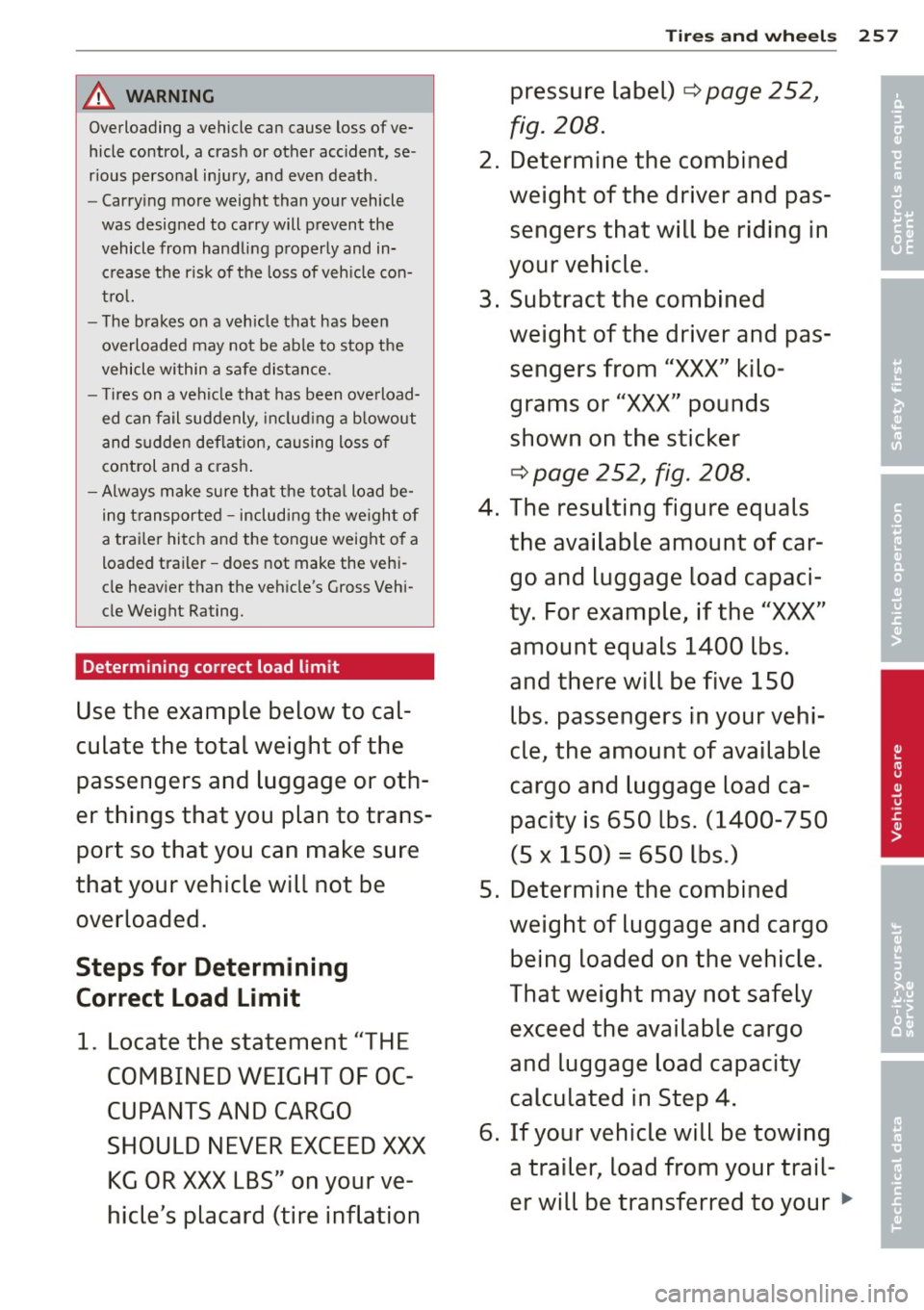
A WARNING ,~
Overloading a vehicle can cause loss of ve
hicle control, a crash or other accident, se
rious persona l injury, and even death .
- Carrying more weight than your vehicle
was designed to carry will prevent the
vehicle from handling properly and in crease the risk of the loss of vehicle con
trol.
- The brakes on a vehicle that has been
overloaded may not be able to stop the
vehicle within a safe distance.
- Tires on a vehicle that has been overload
ed can fail suddenly, including a blowout
and sudden deflation, causing loss of
control and a crash.
- Always make sure that the total load be
ing transported -including the weight of
a trailer hitch and the tongue weight of a
loaded trailer -does not make the vehi
cle heavier than the vehicle's Gross Vehi
cle Weight Rating.
Determining correct load limit
Use the example below to cal
culate the total weight of the
passengers and luggage or oth
er things that you plan to trans
port so that you can make sure
that your vehicle will not be
overloaded.
Steps for Determining Correct Load Limit
1. Locate the statement "THE
COMBINED WEIGHT OF OC
CUPANTS AND CARGO
SHOULD NEVER EXCEED XXX
KG OR XXX LBS" on your ve
hicle's placard (tire inflation
Tires and wheels 257
pressure label) ¢ page 252,
fig. 208.
2. Determine the combined
weight of the driver and pas
sengers that will be riding in
your vehicle.
3. Subtract the combined weight of the driver and pas
sengers from
"XXX" kilo
grams or
"XXX" pounds
shown on the sticker
¢ page 252, fig. 208.
4. The resulting figure equals
the available amount of car
go and luggage load capaci
ty. For example, if the
"XXX"
amount equals 1400 lbs.
and there will be five 150
lbs. passengers in your vehi
cle, the amount of available
cargo and luggage load ca
pacity is 650 lbs. (1400-7 50
(5
X 150) = 650 lbs.)
5. Determine the combined weight of luggage and cargo
being loaded on the vehicle.
That weight may not safely
exceed the available cargo
and luggage load capacity
calculated in Step 4.
6. If your vehicle will be towing
a trailer, load from your trail
er will be transferred to your
i,,,.
•
•
Page 260 of 314
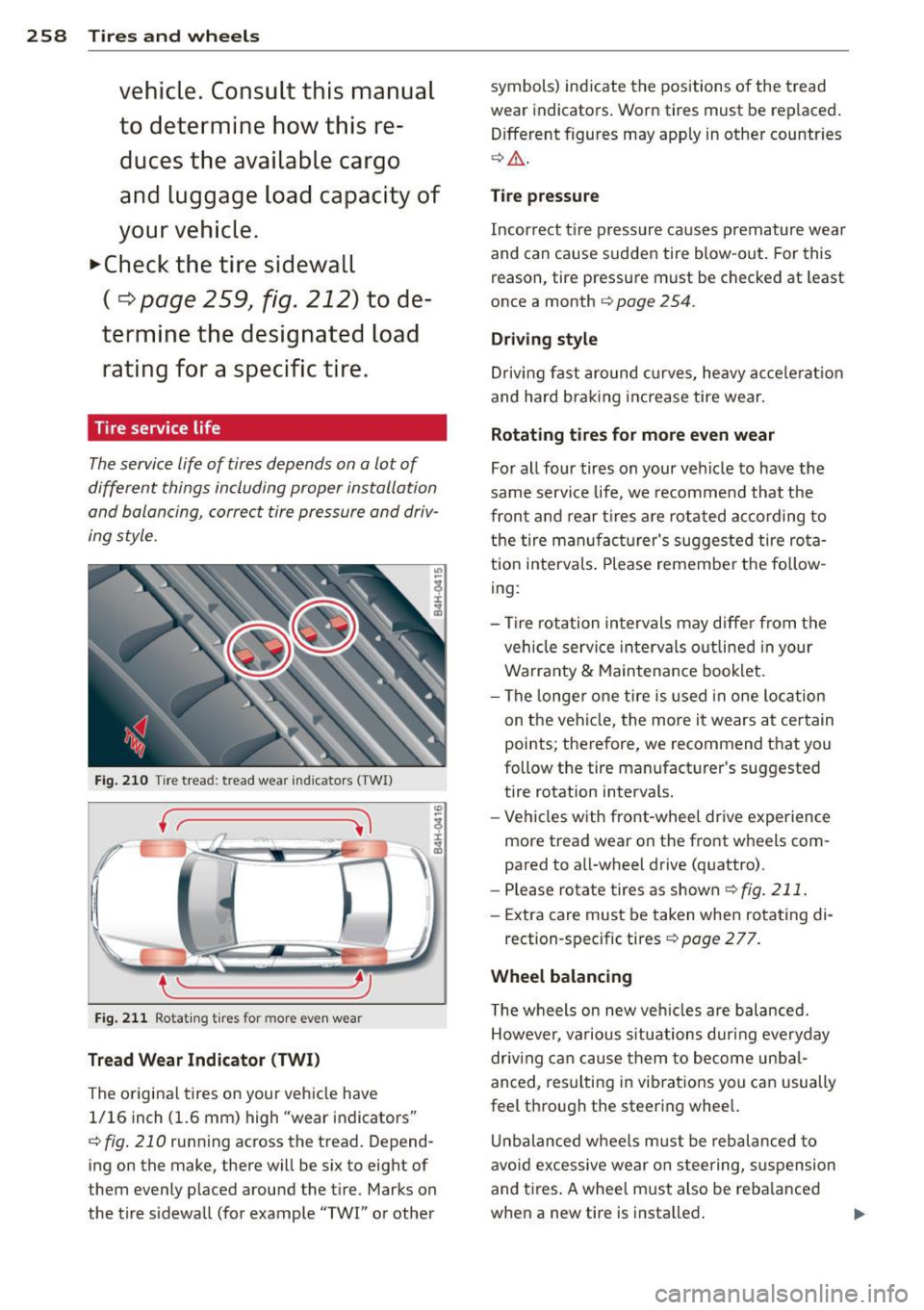
258 Tires and wheels
ve hi cle. C onsult thi s m anual
t o deter mine how this re
d uce s the availabl e cargo
a nd lug gage lo ad ca pacity of
yo ur vehicle .
.,.Che ck the tire sidewall
(¢ page 259 , fig . 212 ) to de
termine the de signa ted lo ad
rating for a specific tire .
Tire service life
The service life of tires depends on a lot of
different things including proper installation
a nd balan cing, correct tire pressure and driv
ing style.
Fig . 210 Tire tread: tread wea r ind icato rs (TWI)
( r------
{ \.._ ______ _.
F ig. 211 Rotat ing t ires for more even wear
Tread Wear Indicator (TWI)
The o rigina l tires on your veh icle have
1/16 inch (1.6 mm) high "wear indicators"
c:::> fig . 210 running across the tread. Depend
ing on the make, there will be six to eight of
them evenly p laced around the t ire . Marks on
the tire s idewall (for example
"TWI" or other symbols) ind
icate the positions o f the tread
wear indicato rs . Worn tires must be replaced .
Different figures may app ly in other countr ies
¢ Ll:). .
Tire pressur e
Incorrect t ire pressure ca uses prema ture wear
and can cause sudden tire blow -out . For this
reason, tire pressure must be checked at least
once a month
c:::> page 254.
Driving style
Dr iving fast around c urve s, he avy a ccele rat ion
and hard braking inc rease tire wear.
Rotating tires for more even wear
Fo r all four tires on your veh icle to have th e
same service life, we recomme nd that the
fron t and rear tires a re rotated ac co rd ing to
the tire m an ufa ctu rer's suggested tire ro ta
tion intervals . Please remembe r th e fo llow
ing :
- Tire rotation in tervals may diffe r from the
ve hicle service inte rva ls o utlin ed in your
Warranty
& M aintena nce booklet.
- The longe r one tire is used in one lo cation
on t he veh icle, the more it wears at cer tain
points; there fore, we recommend that you
follow the tire manufact urer's suggested
tire rotation intervals.
- Vehicles w ith front-whee l dr ive experience
more tread wear on the front w heels com
pa red to a ll-wheel drive (q uattro).
- Please rotate tires as shown
c:::>fig . 211.
- Extra care mus t be taken when ro ta ting di-
rection-specific tires¢
page 2 77.
Wheel balancing
The wheels on new ve hicles are balanced.
However, va rious s ituatio ns dur ing everyday
driv ing c an cause them to become unbal
anced, res ulting in vib rations you can usually
feel thro ugh the steering whee l.
Un balanced w hee ls mu st be rebalanced to
avo id excessive wear on steering, s uspension
and t ires . A whee l m ust also be reba lance d
when a new tire is insta lled .
ll-